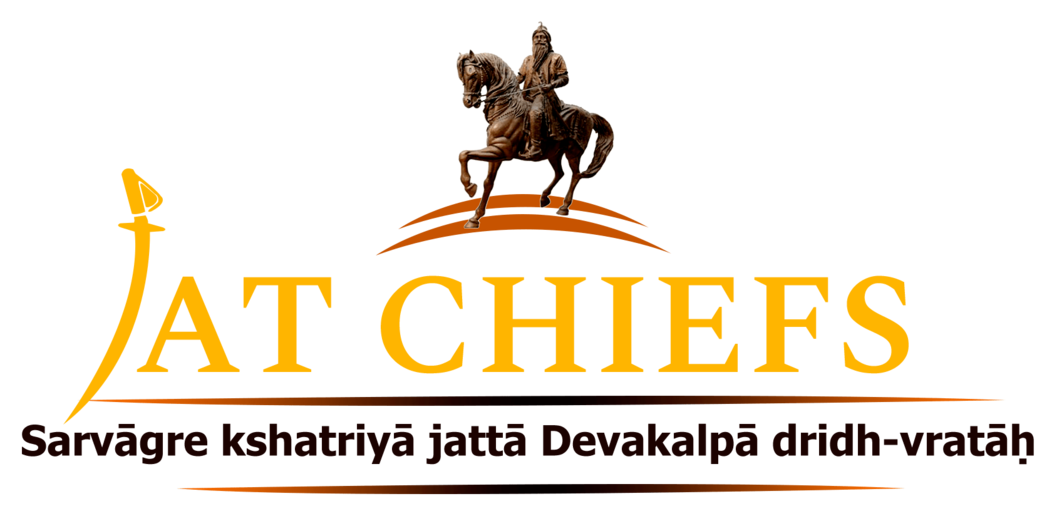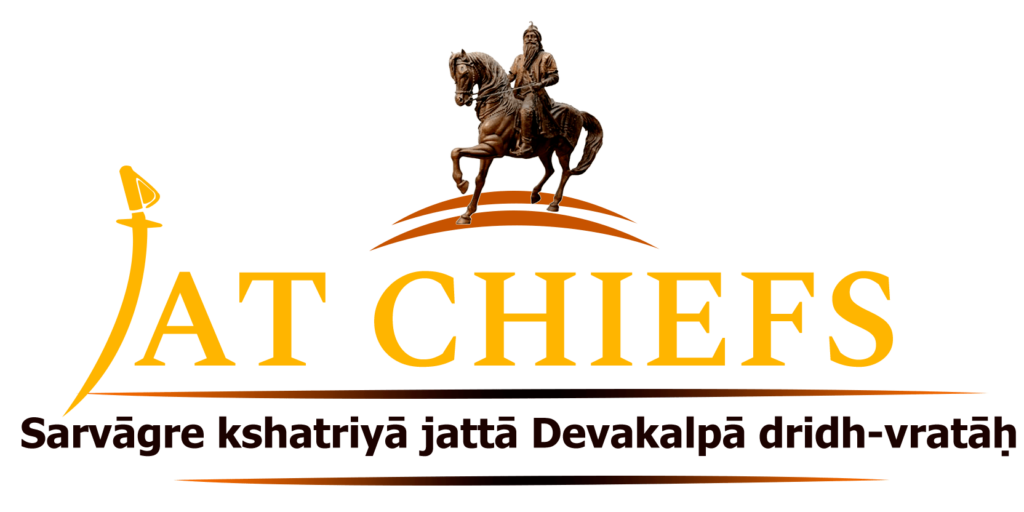This family descends from a respectable stock of Manjha Jats, formerly resident at Moran Kalan in the Nabha territory. Mal Singh, the first of the family to become a Sikh, is stated to have left Nabha about 1760 for the Punjab, where he entered the service of Sardar Charat Singh Sukerchakia as a sowar, and was killed after some years in the Dhani campaign. His son, Dhana Singh, about the yoar 1800, enlisted in the force of Sardar Fate Singh Kalianwala as a trooper, and soon rose in the favour of that chief, obtaining an independent command. He fought in the Kalianwala contingent in the Bhatti and Kasur campaign.
On the death of Sardar Fateh Singh at Narayangarh in 1807, Dhana Singh entered the service of the Maharaja, who gave him & jagir at Bilasor, near Tarn Taran, worth Re. 2,000.He was one of the agents sent by Maharaja Ranjit Singh to Wazir Fate Khan of Kabul to arrange the interview which took place between them at Jhelum on the lat December, 1812. About this time Dhan Singh received the jagir of Talagang in the Jhelum district, worth Ra. 33,000. In the campaign of 1810 against Fateh Khan of Sahiwal, he received a wound in the face; and in July, 1813, he fought in the battle of Attock, when Fateh Khan Baraksai was defeated by Diwan Mokham Chand. He accompanied the detachment of Ram Dyal and Dal Singh Naherna in the first unsuccessful expedition against Kashmir, and received in a skirmish a sword-cut on the arm. The Sardar fought gallantly at the siege of Multan in 1818, and was one of the foremost in the assault. The jewelled sword and ahield of Nawab Muzallar Khan fell into his hands, and were brought by him to the Maharaja, who give him a jagir worth Re. 5,000, which was soon exchanged for another near Talagang. In 1819 he served in the second Kashmir expedition, and in 1821 at the siege of Manker, where he was again wounded. At this time Dhana Singh was much favoured by the Maharaja Ranjit Singh Of Lahore was greater, or whose advice was more regarded. He was present at the capture of Jahangir and et the battle of Teri in 1823, and continued for some time in the Peshawar district under the command of Sardar Budh Singh Sandhawalia Of Raja Sansi and Prince Kharak Singh. Bachatar Singh, eldest son of Sardar Dhana Singh, entered the army about 1827, and his service was at Bahawalpur, where he was sent to receive the tribute. In 1823 Dhan Singh accompanied the force sent to seize Kangra, when Raja Anirudh Chand fed across the Sutlej to avoid an alliance with Raja Dhian Singh, minister at Lahore. When Peshawar was occupied by the Sikhs in force, Bachatar Singh was sent to Shabkadar, where a new cantonment had been laid out and a fort built by Sardar Chattar Singh Attariwala. He was stationed there when the Afghan army attacked that post and the fort of Jamrud in April, 1837. Dhana Singh heard of the defeat of the Lahore army and of the death of Hari Singh Nalwa as he was marching to Peshawar. He was ordered to join the relieving force of Raja Dhian Singh, which advanced with all haste to the assistance of the army, which was surrounded by the Afghans and reduced to the last extremity. In January, 1839, Sardars Bachatar Singh and Hukam Singh were sent with the Lahore force escorting Shahzada Timur, son of Shah Shuja, to Peshawar; and a few months later Hukam Singh returned to Lahore with Prince Nao Nihal Singh, who started for the capital immediately after he had received news of the death of his grandfather, Ranjit Singh. In 1841, after Maharaja Sher Singh had ascended the throne, Hukam Singh was sent with Budh Singh Malal to Kulu to bring into lahore his cousins Sardar Lehna Singh and Kahar Singh Sandhawalia Of Raja Sansi as prisoners. This duty he performed, and received an increase to his jagirs of Rs. 8,000 and a grant of Rs. 2,000 from the Kashmir customs. Bachatar Singh died in 1840, and his father, Dhana Singh, in May, 1843. The death of the latter was the cause of some ill feeling on the part of the Lahore Government towards the British, in the following manner: -The native village of Dhann Singh was, as has been already stated, Moran in the Nabha territory. Campaign, when he was in high power with Ranjit Singh, he begged that Moran might be obtained for him in jagir. The Maharaja accordingly applied to the Raja of Nabba, who, in May, 1819, made him a grant of the village in exchange for certain villages which the Maharaja gave to the sister of the Nabha Chief for her life. Ranjit Singh, on obtaining Morun, gave it in jagir to Sardar Dhana Singh, who held it till his death, and, although residing himself at court, kept there his family and much of his property. The Maharaja of Nabha had for some time before Dhana Singh’s death desired to resume the village; for the Sardar never obeyed his orders or tendered him any allegiance; but the British authorities, who had a regard for the fine old chief, interposed in his behalf. But when Dhana Singh died, Maharaja Davindra Singh of Nabha, armed with a letter admitting his right from Sir George Clerk, and a letter from Maharaja Kharak Singh permitting him to resume the village, marched tropes against it and took possession by force, killing and wounding some of the Malwai retainers and seizing the property of Hukam Singh, the son of the deceased Sardar. Hukam Singh loudly protested against this treatment; but before any action had been taken by either Government in the matter, Maharaja Sher Singh was nasassinated, and every one at Lahore was too busy in looking after his own interests to remember the village of Moran. When, however, tranquillity had been restored, the Lahore Government made a demand for the restoration of Moran, an estate given bybRaja Jaswant Singh of Nabha to Ranjit Singh. To the British authorities this was a new view of the matter. General Ochterlony, Sir George Clerk and Colonel Richmond had never known that the village had been given to the Maharaja, but imagined that it had been a jagir grant from Nabha to Dhana Singh. The grant to Lahore was in iteel! invalid, for a dependent State had no power to transfer a village to an independent one without the consent of the paramount power. The letter, too, which the Raja of Nabha stated he had received from Maharaja Kharak Singh allowing him to resume the village, turned out to be no more than a copy of a copy. The week-minded Maharajah may have drafted such a letter, and the Raja may have obtained, through secret influence, a copy of it, but Raja Dhian Singh, the minister at Lahore, had never sanctioned it, and its authenticity was doubtful in the extreme. The result was that Moran was restored neither to the Lahore Empire nor to Hukam Singh; and the Raja of Nabha received the sharpest reprimand for his unstraightforward conduct. This incident would have been unworthy of so much notice in this place, had not the decision of the British Government irritated, in no small degree, the Sikh nation. There can be no possible doubt but that the conduct of the British Government was just and necessary; but the Sikhs were not this time in a feverish and excited state. Every precaution, which the lawlessness of the Sikh army forced upon the British, they considered as hostile to themselves; and the refusal to make over the village of Moran to Lahore, although its first transfer was clandestine and invalid, they considered as a deliberate insult. To the other jagirs of his father, Hukam Singh succeeded, and with the grants of Maharajah Sher Singh, personal to himself, his estates amounted to Ra. 75,000 per annum. He wee present in the garden of Shah Bilawal when the Maharaja was assassinated by the Sandhawalias Of Raja Sansi, and in the subsequent struggle was severely wounded in the shoulder. Little is known of Huham Singh during the two following years, when he appears to have lived a retired life. He was killed at the battle of Sobraon in Pebruary, 1846, and goon after his death Raja Lal Singh reduced the jagirs to Re. 25,000, which were continued to Sardar Kirpal Singh, subject to the service of sixty borse. Kirpal Singh was with Maharaja Sher Singh at Multan in 1848. When the Raja’ force rebelled, Kirpal Singh separated himself from it, and with a few of his sowars came into the camp of Major Edwardes, with whom he had previously served in Bannu. His personal jagir of Rs. 11,000, was on annexation confirmed to him for life, and a new jagir of Rs. 5,000, for loyalty at Multan, granted in perpetuity. The jagir was subject to the payment of a pension of Re. 1,500 per annum to Chand kaur, widow of Sandar Hukam Singh. This lady died in 1863. Sardar Kirpal Singh enlisted sepoys and showed himaelf well affected to Government in 1867, and received a Khilnt of Ra. 500 and asanad of approbation. He died in 1850, leaving an only son, Sarup Singh, who was educated at the Labore Government School, to succeed him. Sarup Singh died in 1904 leaving two sons, Jhanda Singh and Fateh Singh, who inherited his jagir and property in equal shares. The jagir held by Sarup Singh, which descended to his children, yielded in 1909 Ra. 10,000 per annum and included the revenues of eleven villages in the Tabsils of Sharakpur, Chunian and Lahore. Sarup Singh also owned some lands in the village of Bhikawal, Lahore and Nur Manabad in Ferozepore. The widow of Sardar Kirpal Singh received an allowance of R s. 1,200 per annum until her death in 1892, and Sardar Sarup Singh’s widow drew Re. 150 per annum from the Court of Wards, under whose management the estate passed at Sarup Singh’a death. Jhanda Singh was educated at the Khalsa College, Amritsar, and wag married in the well-known Manihala family of the Lahore district. Later in life he developed extravagant habits, as the result of whicha large portion of his property was mortgaged. He died in 1930, leaving behind one son, Shivdeo Singh, who received education at the Aitchison College, Lahore. Shivdeo Singh is married in the Chahil family of Patiala and is at present looking after his inheritance the annual in come of which is about Rs. 12,000. Fateh Singh, the younger brotber of Sardar Jhanda Singh, was educated at the Aitchison College, Lahore, from where he obtained the diploma in 1912 and also won the Rivaz Gold Medal for having been, during the previous year, the best all round boy in the College. He also proved a sporteman and captained various College teams such as cricket, hockey, football and tent pegging. Tor three year Sardar Fateh Singh studied at the Government College, Lahore. He is married to the grand-daughter of Raja Badan Singh, C.I.E., of Malodh and has one son and three daughters.
He later became the Private Secretary to the Ruler of Faridkot. Soon after this appointment the Punjab Government selected him as an Extra Assistant Commissioner, but the Sardar preferred to continue in the former post. On the death of the Maharaja of Faridkot in 1918, Sardar Fateh Singh was appointed, according to the late ruler’a will, Pinance and Military Member of the Council of Administration. During the long minority of the present ruler, the Sardars’ devoted work continued and won him in 1931 the title of Sarder Bahadur from the Punjab Government. At the concession of His Highness Maharaja Harindar Singh Brar Of Faridkot in 1934, Sardar Bahadur Sardar Fateh Singh became his Home Secratary. He has been recently granted a life jagir, worth Rs. 4,100 per annum by the Maharaja. The Sardar is exempt from the operation of certain provisions of the Arms Act, and holds the seat in the Provincial Darbar
which at one time belonged to his father.
Genealogy
- Chaudhari Mal Singh ,founder of Malwai Estate, His formerly resident at Moran Kalan in the Nabha State territory, later he beocme Sikh, was stated to have left Nabha about 1760 for the Punjab, where he entered the service of Sardar Charat Singh Sukarchakia as a sowar, and was killed after some years in the Dhani campaign.
- Sardar Dhanna Singh, Jagirdar of Moran Kalan 1819/1843; born 1775, he enlisted in the force of Sardar Fateh Singh Kalianwala as a trooper, rising in favour until he was given an independent
command, he fought in the Kalianwala contingent, in the Bhatti and Kassur campaigns, after the death of Sardar Fateh Singh Kalianwala in 1807, he entered the service of Maharaja Ranjit Singh who gave him a jagir at Bilasur near Taran, worth around Rs2,000; around 1812 he was granted
the jagir of Talah Gang in Jhelum district worth Rs33,000, he fought gallantly at the siege of Multan in 1818, and in the second Kashmir campaign in 1819 and at the siege of Mankerah in 1821; he was present at the capture of Jahangira Fort and at the battle of Teri in 1823, and remained on duty for some time in the Peshawar district, eventually taking part in the battle of Jamrud in April 1837, married and had issue. He died in May 1843.
- Sardar Bachittar Singh, he entered army service in 1827, and first served at Bahawalpur, then in 1834 he was sent to Shabkadar, and later took part in the battle of Jamrud in
April 1837, married a daughter of Sardar Sher Singh Jagdeo, and had issue. He died 1840.
- Sardar Kirpal Singh (qv)
- Sardar Hukum Singh (qv)
- Bibiji (name unknown) Kaur, married Sardar Khazan Singh of Bhadaur, C.S.S.
- Bibiji (name unknown) Kaur, married Sardar Narayan Singh of Bhakhna in Amritsar district.
- Sardar Bachittar Singh, he entered army service in 1827, and first served at Bahawalpur, then in 1834 he was sent to Shabkadar, and later took part in the battle of Jamrud in
April 1837, married a daughter of Sardar Sher Singh Jagdeo, and had issue. He died 1840.
- Sardar Hukum Singh, Head of the Malwai Family 10843/10846; he succeeded to his father's jagirs except for Morqan Kalan which was resumed; in 1839 and with his brother he was sent to Peshawar as an escort for Shahzada Timur Durrani, married Sardarni Chand Kaur, died 1863, daughter of Sardar Fateh Singh of Mattu. He was killed at the battle of Sobraon in February 1846.
- Sardar Kirpal Singh, Head of the Malwai Family 1846/1859; he succeeded his uncle to the family jagirs which had been further reduced; during the rebellion at Multan he remained loyal for
which he was rewarded with a grant of jagir worth Rs5,000 in perpetuity, after annexation he was confirmed in his possession of his personal jagir for life, married a daughter of Sardar Wazir Singh of Lidhran, C.S.S., she died 1892, and had issue, an only son. He died 1859.
- Sardar Sarup Singh (qv)
- Sardar Sarup Singh, Head of the Malwai Family 1859/1904, born 1850, educated at the Government School, Lahore; a Provincial Darbari; married a daughter of Sardar Kehar Singh
Sindhanwalia (see Lahore), and had issue, two sons, who inherited his property in equal shares. He died 1904.
- Sardar Jhanda Singh (qv)
- Sardar Bahadur Sardar Fateh Singh, born 1893, educated at Aithchison College, Lahore (Diploma, 1912) and at the Government College, Lahore; Private Secretary to the Raja of Faridkot; he was appointed Finance and Military Member of the Council of Administration after the Rajas death in 1918; he was granted the title of Sardar Bahadur
by the Punjab Government; a Provincial Darbari like his father; married a granddaughter of Raja Badan Singh C.I.E. of Malaudh, and had issue. one son and three daughters.
- Sardar Surindar Singh, born 1922.
- Sardar Jhanda Singh, Head of the Malwai Family 1904/1930, educated at Khalsa College, Amritsar; married a Bibi of the Kamla family, and had issue. He died 1930.
- Sardar Shivdeo Singh (qv)
- Sardar Shivdeo Singh, Head of the Malwai Family 1930/-, born 1913, educated at Aithchison College, Lahore; married a Bibi of the Chahil family of Patiala, and had issue.
- Bibiji Jitender Kaur Sahiba
- Sardar Sukh Deo Singh Alias Sukhdev Singh ,born 1936
- Sardar Sukhdev Singh, Head of the Malwai Family born 1936/-educated at Welham Boys School, Dehradun and Yadvindra Public School, Patiala. He was lived out his life at his farm near Kiccha, Distt. US Nagar, Uttrakhand. He was a fond hunter and fisherman in his younger years, was married had issue with one son, he was died in 2019.
- Prab Jyot Singh Mann
- Sardar Prab Jyot Singh Mann, Head of the Malwai Family in Meerut in 1996.




